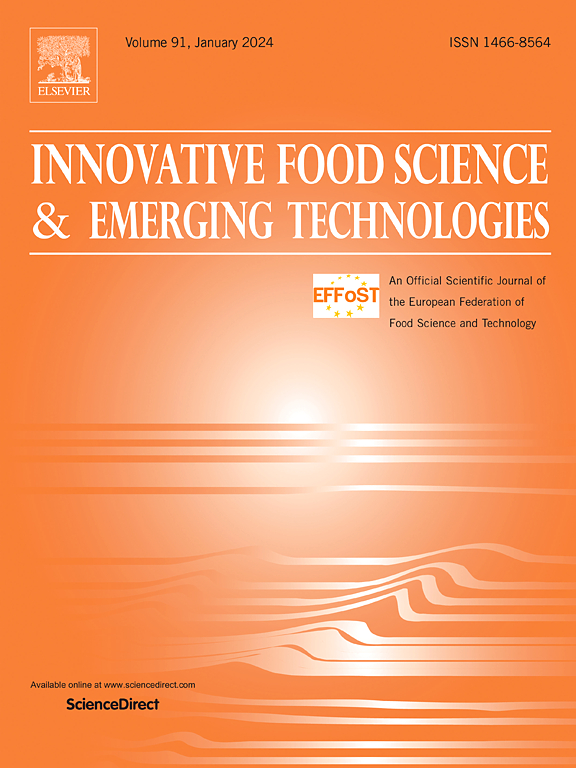比较高压、脉冲电场和热处理对覆盆子汁品质属性的影响
IF 6.8
1区 农林科学
Q1 FOOD SCIENCE & TECHNOLOGY
Innovative Food Science & Emerging Technologies
Pub Date : 2025-07-15
DOI:10.1016/j.ifset.2025.104101
引用次数: 0
摘要
覆盆子汁是一种营养丰富的饮料,因其高浓度的花青素、维生素C和挥发性香气化合物而备受重视,这有助于其健康益处和感官吸引力。然而,加工方法会显著影响这些质量属性。本研究比较了热巴氏灭菌(TT)、高压处理(HPP)和脉冲电场(PEF)在两种强度水平下对覆盆子汁的理化和感官特性的影响。评估参数包括颜色、粘度、浊度、褐变指数(BI)、花青素稳定性、抗坏血酸保留和挥发性香气化合物。热处理引起显著的颜色变化,加速褐变反应,降解花青素和花香化合物。高温热处理(80°C)导致最明显的褐变和颜色损失,降低感官质量。HPP处理表现出压力依赖效应,低强度HPP处理由于酶激活导致最高BI,而高强度HPP处理减缓褐变。HPP还降低了可能由于果胶降解而导致的粘度和浊度。相比之下,经pef处理的样品颜色和褐变变化最小,但抗坏血酸含量最低,可能是由于加工过程中的温度峰值。多因素分析发现,挥发性香气化合物,尤其是α-离子酮和β-离子酮,以及粘度、浊度和BI是不同处理之间的关键区分因素。特别是,抗坏血酸不是模型的主要贡献者,突出了其在治疗分化中的有限作用。研究结果表明,高强度PEF处理在营养保留和感官质量之间取得了适当的平衡,而TT和HPP处理需要优化以尽量减少质量损失。本文章由计算机程序翻译,如有差异,请以英文原文为准。
Comparing the impact of high pressure, pulsed electric field and thermal treatments on the quality attributes of raspberry juice
Raspberry juice is a nutrient-rich beverage valued for its high concentrations of anthocyanins, vitamin C, and volatile aroma compounds, which contribute to its health benefits and sensory appeal. However, processing methods can significantly impact these quality attributes. This study compared the effects of thermal pasteurization (TT), high-pressure processing (HPP), and pulsed electric fields (PEF), each at two intensity levels, on the physico-chemical and sensory properties of raspberry juice. Evaluated parameters included colour, viscosity, turbidity, browning index (BI), anthocyanin stability, ascorbic acid retention, and volatile aroma compounds. Thermal treatments caused significant colour changes, accelerating browning reactions and degrading anthocyanins and floral aroma compounds. Higher thermal treatment (80 °C) resulted in the most pronounced browning and colour loss, reducing sensory quality. HPP treatments demonstrated pressure-dependent effects, with low-intensity HPP treatment causing the highest BI due to enzyme activation, while high-intensity HPP moderated browning. HPP also reduced viscosity and turbidity likely due to pectin degradation. In contrast, PEF-treated samples exhibited minimal changes in colour and browning but retained the lowest ascorbic acid levels, likely due to temperature spikes during processing. Multifactorial analysis identified volatile aroma compounds, particularly -ionone and -ionone, along with viscosity, turbidity, and BI, as the key differentiating factors among treatments. Particularly, ascorbic acid was not a primary contributor to the model, highlighting its limited role in treatment differentiation. The findings suggest that high-intensity PEF treatment offers the appropriate balance between nutrient retention and sensory quality, while TT and HPP treatments require optimization to minimize quality losses.
求助全文
通过发布文献求助,成功后即可免费获取论文全文。
去求助
来源期刊
CiteScore
12.00
自引率
6.10%
发文量
259
审稿时长
25 days
期刊介绍:
Innovative Food Science and Emerging Technologies (IFSET) aims to provide the highest quality original contributions and few, mainly upon invitation, reviews on and highly innovative developments in food science and emerging food process technologies. The significance of the results either for the science community or for industrial R&D groups must be specified. Papers submitted must be of highest scientific quality and only those advancing current scientific knowledge and understanding or with technical relevance will be considered.

 求助内容:
求助内容: 应助结果提醒方式:
应助结果提醒方式:


